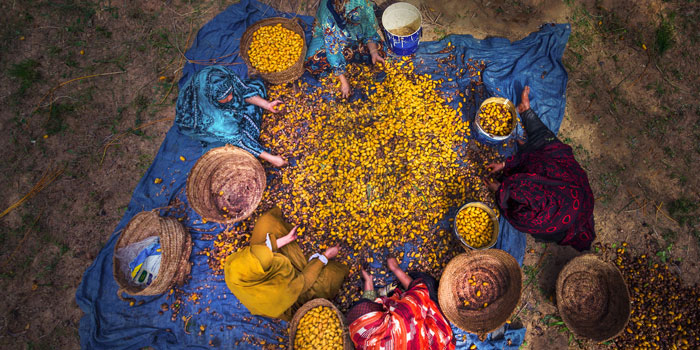Système oasien de Siwa, Egypte
SIPAM depuis 2016

Site location : Siwa Oasis, Maaraqi area, Egypt
Population working for this system : 28,300 person in the region
Topological characteristics : sand dunes
Climatic classification : desertic climate with extreme aridity
Primary Income Sources : Agriculture, date palm production
-------------------------------------------------------------------------
Global importance
Siwa oasis is one of the best illustrations of farmers’ ingenuity to adapt agriculture to very harsh climatic conditions. This smart adapted system is based on date palm agriculture combining with other crops such as olive trees and alfalfa that allows local people to respond to their needs. Water management has allowed to preserve this resources.
Recognized as a very ancient agrarian area, Siwa oasis is a repository of distinctive date palm varieties and other crops of which the history goes back to the distant past. Strongly linked to local culture, Siwa is unique because Siwans people have Berber ancestry and have managed to preserve much of their linguistic and cultural heritage.
Food and livelihood security
Agriculture has been, and continues to be, the most important economic activity in Siwa and is the foundation for the Siwan livelihoods. There are currently around 280,000 date palms generating about 25,000 tons of dates per year, which correspond to approximately 2% of Egypt’s total date production. Similarly, Siwa is a significant national olive producer with a total yearly output of 27,500 tons.
Siwa dates and olive orchards still harbour a diversity of vegetables, fruits and medicinals, some of which are planted predominantly for sale. Cultivation of grapes, tomatoes, cucumbers, molukia (Corchorus olitorius), Siwa spearmint (Mentha spicata) and karkade (Abelmoschus sabdariffa), with significant horticultural operations in the oasis generate jobs and local income.
Biodiversity and ecological functions
Siwa is a globally significant in situ repository of plant genetic resources, especially because its unique adapted varieties of date palm, olive and secondary crops that are highly esteemed for their quality and continue to play a significant role in rural livelihoods, both for nutrition and income. The Siwan crop inventory comprises 46 crop species. Regarding livestock, sheep, goat and chickens are breeded.
Siwa supports a distinct and wide-ranging collection of animal species, including at least two species of amphibians, 28 mammals, 32 reptiles, 52 insects, 92 soil fauna and a variety of birds. Among these, several species appear to be unique at the Siwa region.
Knowledge systems and adapted technologies
Siwa oasis is dominated by intensively cultivated date palm gardens, which traditionally are inter-cropped with fruits, vegetables, fodder crops and occasionally cereals. This results in a three-storey canopy structure with date palms occupying the highest stratum, fruits at intermediate height and all other crops up to one meter above ground level. This multi-layered system creates a micro climate allowing other crops to grow under palm trees.
Siwan farmers have a very rich knowledge regarding the maintenance of palm trees, the harvest and postharvest products from date palm trees. Indeed, several agricultural practices, such as pollination, harvesting, and pruning require access to climb to the crown of the tree at least three times per year, and in old trees reaching 15 meters in height, this can be challenging.
Cultures, value systems and social organizations
The traditional society of Siwa is based on so-called qabilas, groups of people with a common ancestry, but also open to outsiders with no kinship links. Regarding social organisation in agriculture, the ahisab is the supervisor who oversees the distribution of water to the plots of individual farmers and determines the precisely timed schedules for opening and closing of irrigation canals.
Looking at the cultural specificities of the site, because of their isolation Siwans developed a unique culture manifested in its crafts, although some of it has been lost. There is a wide assortment of historic basketry and palm frond products that were finely woven and decorated. In addition, Siwa oasis is distinguished by a range of archaeological treasures going back to Pharaonic and Ptolemaic epochs. Due to its long isolation from outside influences, Siwan local culture is unique embodied by its mud-salt brick architecture, peculiar social institutions and a rich heritage of handicrafts.
Remarkable landscapes, land and water resources management
The Siwa landscape is an eminently anthropogenic one. Without the agricultural use and human hydrologic intervention, the oasis would look very much like the surrounding desert, including few patches of sparse natural vegetation relying only on natural springs.
Concerning water resource management, the common irrigation method in Siwa is traditional surface irrigation by gravity in small basins, which vary in size from 4 to 16 square meters. The advantages of this method include simplicity, low energy and capital needs, and the ease of the leaching process. Water is abundant from the aquifers underlying the oasis, and the ease of drilling productive wells has led to a large number of them.

